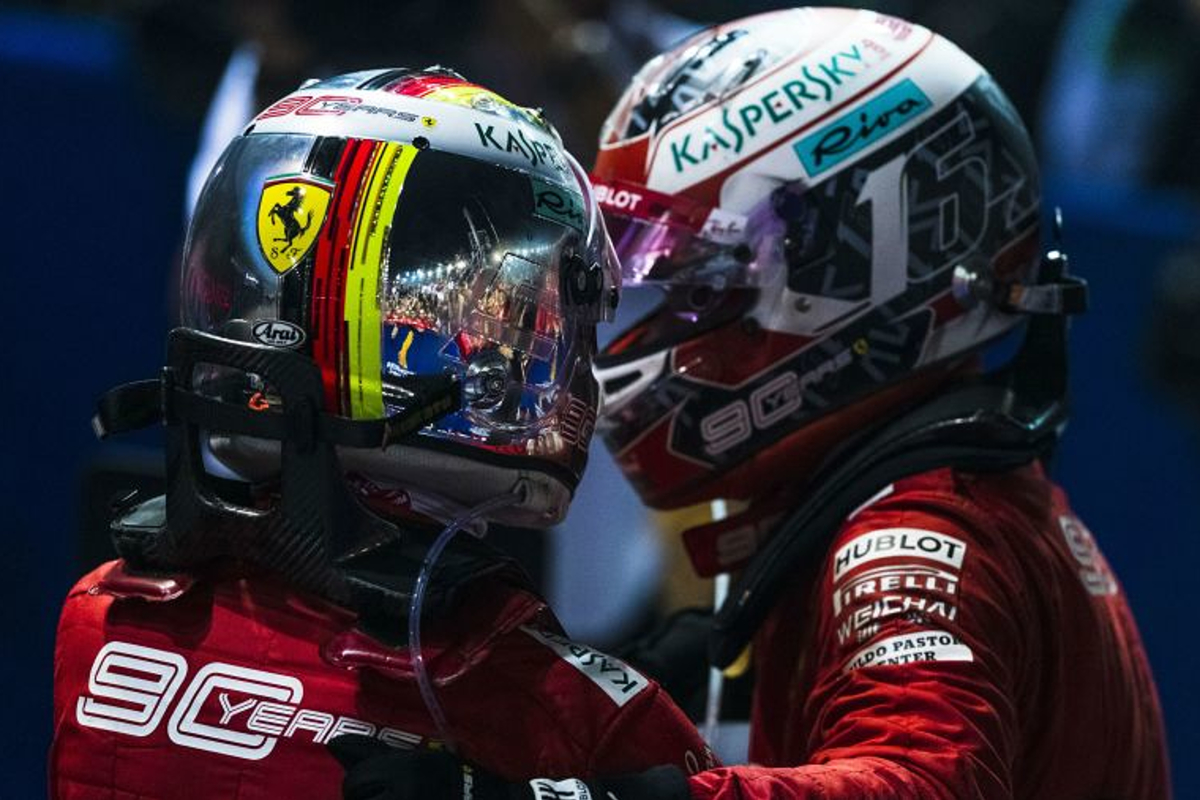Ferrari may be the only team on the Formula 1 grid that could catch criticism for turning a 1-3 result into a first 1-2 of the season and, although Sebastian Vettel's Singapore Grand Prix triumph shows key improvements have been made, the Scuderia's problems may have only just begun.
After a first part of the season coloured by near-misses and disappointment, Ferrari have been near flawless since the summer break, with three pole positions and three victories in as many races.
Charles Leclerc's successes in Belgium and Italy, while not foregone conclusions, had certainly been anticipated, but the hot streak was supposed to be doused in the race around Marina Bay.
Although Vettel had been on the podium in Baku, Monaco and Hungary the SF90 was not expected to feature at the front at this latest trip to a high-downforce street circuit.
And team principal Mattia Binotto was typically understated about the upgrade package being brought to Singapore.
"A few parts" would turn out to be a potential game-changer, with the strongest engine on the grid now fitted to a chassis capable of extracting more of its power around the corners.
It comes in black-and-white contrast to the 'upgrade' brought to Singapore 12 months prior, which made the car three tenths per lap slower and finally ended Vettel's fading title hopes.
That misstep almost certainly bled over into 2019, but if this burst of form is truly sustainable, it raises the hopes of a campaign to remember in 2020.
If Ferrari are to remain a fixture in the fight at the front, it will also put the team's decision-making into the spotlight, as it has been for much of the year.
Leclerc has certainly done enough to wipe out the "priority" bestowed upon Vettel by Binotto at the start of the season, but the German was certainly given the optimum strategy in Singapore, despite starting, and circulating, two places behind Leclerc.
In truth, Leclerc's tactics of backing into Lewis Hamilton to limit Mercedes' options also meant that finding a clear spot of track of his own to emerge onto was tricky and that was borne out at Vettel's pit-stop, when Max Verstappen followed him in for a service from Red Bull.
Vettel and Verstappen exited the pit-lane with a few seconds of each other but, crucially, Nico Hulkenberg filled those few seconds and held up the Dutchman, who might have otherwise taken second place.
The potential strength of the undercut had already been displayed by the likes of Hulkenberg, Daniil Kvyat and George Russell having set fastest laps on fresh tyres while the front-runners ambled around, so Ferrari must have known that Leclerc would be in danger of dropping behind Vettel.
Instances of utilising team orders earlier in the season were confused to say the least. Leclerc ignored instructions to remain behind Vettel in Bahrain, and then lost points in the next race in China when he was again ordered aside.
Things came to a head in the Spanish Grand Prix when both drivers were asked to let the other through at different parts of the race as the Ferrari pit-wall seemed to go into meltdown.
Since then, such strict applications of the team hierarchy has been put away, largely in truth due to Leclerc qualifying ahead of Vettel in each of the last eight races and moving ahead of the four-time world champion in the drivers' championship.
A record-breaking fifth win in Singapore has put Vettel back to within six points of his team-mate and the apparent potential of the Ferrari now puts the pair in the hunt for the bigger prizes still on offer over the remainder of the season.
And as the rewards have grown, so too have the cracks in the racers' relationship.
Vettel made no secret of his frustrations at Leclerc after he was denied a tow in qualifying at the Italian Grand Prix, with the youngster going on to win from pole.
In Singapore, it was Leclerc's turn to be frustrated as he sat behind Vettel at three safety car restarts, openly questioning the team each time, with measured celebrations between them in parc ferme and on the podium, despite securing the team's best result since Hungary 2017.
Having finally solved the downforce puzzle, Ferrari's true test – keeping Vettel and Leclerc happy in winning car – may have only just begun.
Related








































 Grand Prix of Australia 2025
Grand Prix of Australia 2025  Grand Prix of China 2025
Grand Prix of China 2025  Grand Prix of Japan 2025
Grand Prix of Japan 2025  Grand Prix of Bahrain 2025
Grand Prix of Bahrain 2025  Saudi Arabian Grand Prix 2025
Saudi Arabian Grand Prix 2025  Grand Prix De Monaco 2025
Grand Prix De Monaco 2025  Gran Premio de España 2025
Gran Premio de España 2025  Grand Prix du Canada 2025
Grand Prix du Canada 2025  Grand Prix of Austria 2025
Grand Prix of Austria 2025  Grand Prix of Belgium 2025
Grand Prix of Belgium 2025  Grand Prix of Hungary 2025
Grand Prix of Hungary 2025  Grand Prix of Azerbaijan 2025
Grand Prix of Azerbaijan 2025  Grand Prix of Singapore 2025
Grand Prix of Singapore 2025  Gran Premio de la Ciudad de Mexico 2025
Gran Premio de la Ciudad de Mexico 2025  Grande Prêmio de São Paulo 2025
Grande Prêmio de São Paulo 2025  Qatar Grand Prix 2025
Qatar Grand Prix 2025  Grand Prix of Abu Dhabi 2025
Grand Prix of Abu Dhabi 2025 